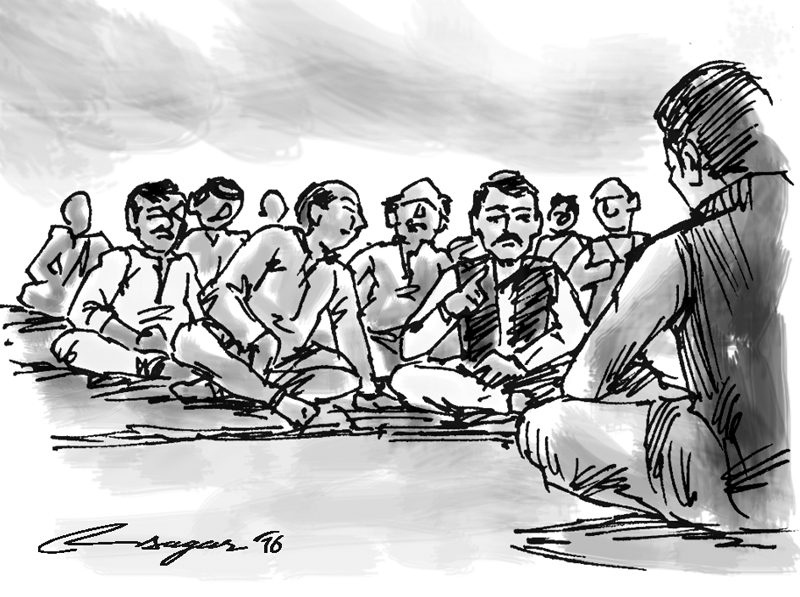Madhesi conundrum: Will it end soon?
The marginalized communities are skeptic about guaranteeing of their proportional representation in parliament and their inclusion in all state organs with the present scheme of things, as the new parliament will be a bicameral House
The process of change of PM Oli’s government, which has already started, may take some time in passing the no confidence motion and forming another government.
However, the standoff will continue if CPN-UML does not cooperate in amending the constitution for which the Madhesi and ethnic groups are agitating. The relevant provisions of the constitution have been opposed since the publication of the first draft of the constitution on August 17, 2015.
The protests continued for forty days, in which more than fifty people were killed. Ultimately, the protesters started sit-in protests on the no-man’s land between Nepal and India.
Their aim was to block supplies from India to Nepal for about four months. And India found this reason convenient to stop supplies too.
This caused hardships to the general people on the one hand and failed to pressurize the government to meet their demands, on the other.
After its failure, the Federal Alliance (FA), a front of 31 parties including indigenous communities, started its second phase of the protest with picketing of the central secretariat for two days and PM’s official residence for one day.
It continued its protest for ten more days in Kathmandu.
However, this too failed in fetching any positive response from the government and it forced the alliance to start a relay hunger strike from June 7, 2016 which ended on July15.
Interestingly, keeping in view the opposition to the constitution, the amendments, which were made to Art. 42, 84 and 286 of the constitution, were merely a window dressing in meeting the demands.
These amendments are, in fact, regressive as they have reverted back to the provisions of 1990 constitution leaving behind the provisions of the Interim Constitution of 2007.
Actually, the endeavour has defeated the very purpose of the demand in regard to making the population the primary basis of determining the number of seats since each district will have at least one constituency.
Similarly, the proportional inclusion of marginalized communities in all state organs has not been guaranteed as per the provision incorporated in the Interim Constitution. Thus, these amendments too are regressive.
Delineation of boundaries of the provinces is a bone of contention as these are against the agreements signed by the government and the Madhesi outfits in 2008.
It is true that the new constitution has incorporated altogether 32 of fundamental rights including right to employment, right to free essential medical services, right to food, right to suitable residence, etc.
However, their enforceability has been made to depend on laws, which are to be enacted within three years, a time unusually longer than what is actually needed.
Similarly, to take care of the interests of the marginalized communities, provisions for constituting commissions for Dalits, indigenous people and Madhesis, seem toothless. However, their relevance will be evaluated after ten years.
The marginalized communities are skeptic about the guaranteeing of their proportional representation in parliament and their inclusion in all state organs with the present scheme of things, as the new parliament will be a bicameral House -- the House of Representatives (Lower House) and the National Assembly (Upper House).
The Lower House will have 275 members to be elected under mixed electoral system with two segments--under FPTP, 165 members will be elected and the rest 110 members under PR with the ratio of 60% and 40% respectively making it a regressive House in contrast with the provisions of the Interim constitution regarding the CA, which had 42% of the seats under FPTP and 58% under PR.
Consequently, in terms of representations, the new House cannot be proportional, as FPTP cannot ensure proportional and inclusive representations.
The new National Assembly (NA) will be a permanent House with fifty-nine members including three nominated members. It will have an equal number of representations from all the provinces irrespective of their populations that vary from 5.5 million to 1.5 million.
Against this disparity, the protesters claim that the population should be the main criterion for determining the number of representations from each province.
There are other points of dissatisfaction too like the discrimination meted out to a citizen who cannot acquire citizenship by descent if his mother has not obtained citizenship certificate at the time of his acquiring the same.
Since only the citizen by descent can occupy the positions of President, Prime Minster, Chief Minister and Speaker etc., he forfeits his right to reach the highest positions.
Although it is aimed at discouraging Nepalese citizens to marry Indian women, it will ultimately affect thousands of Nepalese citizens whose mothers have not obtained their certificates due to ignorance, poverty and illiteracy.
Similarly, there is discrimination against the languages used in different regions. The Nepali language is the only language in which the government communicates. This reduces other languages to the secondary level.
Some groups in the Madhes want Hindi also to be made as an alternate language, as it is the lingua franca for Madhes.
These are some of the main reasons for protesting against the new constitution in the present form and its acceptability seems difficult, if not impossible in the future.






